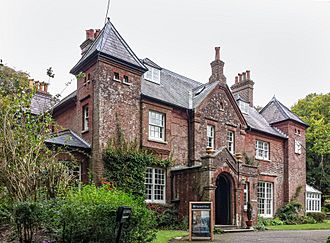Max Gate facts for kids
Quick facts for kids Max Gate |
|
|---|---|

Max Gate 2015
|
|
| General information | |
| Town or city | Dorchester, Dorset |
| Coordinates | 50°42′29″N 2°25′12″W / 50.7081°N 2.4200°W |
Max Gate is a special house in Dorchester, Dorset, England. It used to be the home of a famous writer named Thomas Hardy. He designed and built this house for himself in 1885. Thomas Hardy lived here for many years, until he passed away in 1928.
In 1940, Hardy's sister gave the house to the National Trust. The National Trust takes care of historic places. Today, Max Gate is open for people to visit. It was officially recognized as a very important historic building on May 8, 1970.
What Does Max Gate Look Like?
Max Gate is a Grade I listed building, which means it's super important. Thomas Hardy designed it himself. It was built in 1885 using red bricks. The house has a style called Queen Anne style.
Hardy bought a large piece of land, about one and a half acres, to build his home. He was excited to find old Roman artifacts on the land. His father, who was a builder, and his brother helped him construct the house.
The name "Max Gate" is a clever play on words. There was a nearby toll-house called "Mack's Gate." This was named after a gate-keeper named Henry Mack.
When it was first built, Max Gate had two rooms downstairs and two rooms upstairs. But Thomas Hardy soon needed more space. The house was made bigger in 1895, and more parts were added later. Hardy used three different rooms as his study at different times.
He wanted privacy, so he planted a thousand pine trees around the house. These trees grew very tall and thick. They made the house quite dark inside. After Hardy died, his second wife, Florence, had them removed.
Max Gate's History
Thomas Hardy lived in Max Gate from 1885 until he died in 1928. He lived there with his first wife, Emma. Later, he lived there with his second wife, Florence.
Many of his famous books were written at Max Gate. These include Tess of the d'Urbervilles, Jude the Obscure, and The Mayor of Casterbridge. He also wrote a lot of his poetry while living in this house.
In 1940, Hardy's sister, Kate, gave Max Gate to the National Trust. She said that people should always live in the house. It has been lived in ever since.
The house first opened to the public in 1994. At first, you could only visit a few days a week. In 2011, the National Trust opened all three floors. Visitors could see the hall, drawing room, two studies, dining room, and kitchen.
In 2013, two bedrooms were also opened for the first time. One of these was the room where Thomas Hardy wrote The Mayor of Casterbridge. It was also the room where he passed away. The house still has some of Hardy's own furniture. However, his main study was moved to the Dorset Museum.
Ancient Discoveries at Max Gate
Underneath the grounds of Max Gate, there's an ancient site. It's a Neolithic enclosure called Flagstones. This enclosure is about 100 meters wide.
Half of this ancient site is under the house's property. The other half was dug up by archaeologists in 1987. This happened before the Dorchester bypass road was built.

